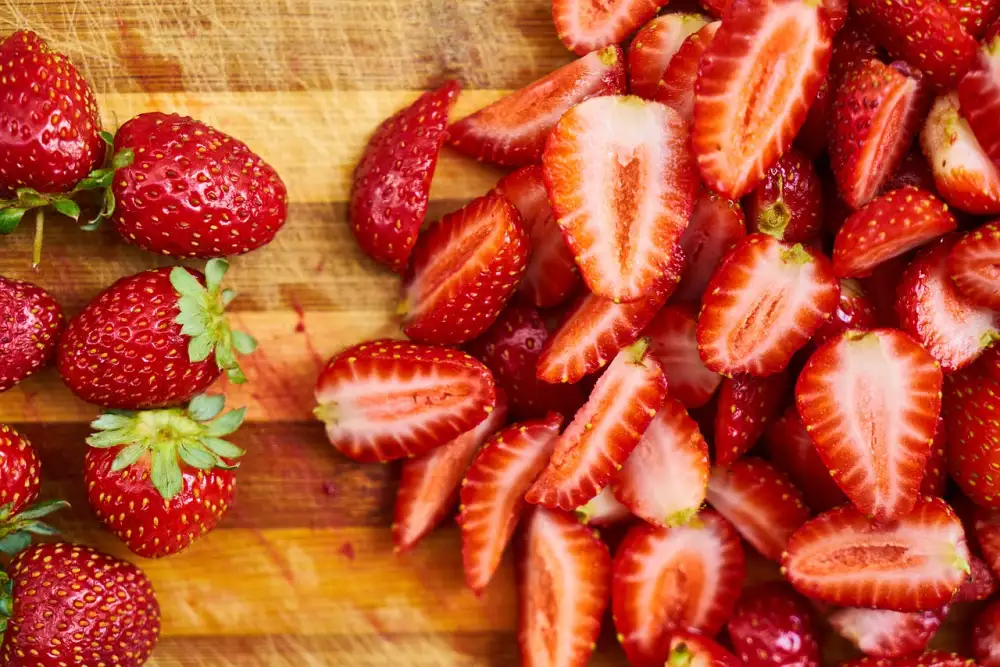Preserve the Freshness: Essential Tips for Keeping Strawberries Fresh

- Proper Storage: Refrigeration is Key
- Prepping Strawberries: Handle with Care
- Washing Techniques: Rinse Before Consumption
- Drying Methods: Pat Dry for Optimal Freshness
- Storing Strategies: Keep Strawberries in a Breathable Container
- Avoiding Moisture: Don't Wash Strawberries Until Ready to Eat
- Extending Shelf Life: Remove Moldy or Overripe Strawberries
- Freezing Strawberries: Preserve the Freshness for Later Use
Strawberries, with their vibrant color and sweet flavor, are a beloved fruit enjoyed by many. However, their delicate nature makes them prone to spoilage if not properly stored. To fully savor the taste and texture of fresh strawberries, it is essential to preserve their freshness. By following these tips and techniques, you can ensure that your strawberries stay juicy, plump, and delicious for as long as possible. So let's dive in and discover the secrets to keeping strawberries fresh!
Proper Storage: Refrigeration is Key
Proper storage is crucial in maintaining the freshness of strawberries. Refrigeration is key to preserving their delicate texture and flavor. As soon as you bring home a batch of strawberries, place them in a clean, dry container lined with paper towels to absorb any excess moisture. Make sure to remove any damaged or moldy berries before storing them in the refrigerator. Keeping strawberries at a temperature between 32-36°F (0-2°C) will help slow down the ripening process and extend their shelf life. Remember, refrigeration is essential for keeping your strawberries fresh and delicious for longer periods of time.
Prepping Strawberries: Handle with Care
When it comes to prepping strawberries, it's important to handle them with care. Strawberries are delicate fruits that can easily bruise or become damaged if not handled properly. To ensure their freshness, gently remove the stems and leaves from each strawberry using a sharp knife or your fingers. Avoid squeezing or pressing too hard, as this can cause the fruit to lose its shape and texture. By handling strawberries with care, you'll be able to enjoy their juicy goodness for longer periods of time.
Washing Techniques: Rinse Before Consumption
Before indulging in the sweet juiciness of fresh strawberries, it is important to give them a thorough rinse. Washing strawberries before consumption helps remove any dirt, bacteria, or pesticides that may be lingering on their surface.
To wash strawberries properly, start by placing them in a colander or strainer. Gently run cool water over the berries, making sure to cover all sides. Use your hands or a soft brush to gently rub the surface of each strawberry, ensuring that any stubborn dirt or residue is removed.
Avoid using soap or detergent when washing strawberries as they can leave behind unwanted flavors and chemicals. Stick to plain water for the best results.
After rinsing, pat the strawberries dry with a clean towel or paper towel. This step is crucial as excess moisture can promote mold growth and reduce their shelf life.
By following these simple washing techniques, you can enjoy fresh and clean strawberries that are ready to be savored in all their natural glory.
Drying Methods: Pat Dry for Optimal Freshness
After washing your strawberries, it's important to dry them properly to maintain their freshness. Instead of air-drying, which can take longer and may lead to moisture retention, opt for patting them dry with a clean kitchen towel or paper towels. Gently place the strawberries on the towel and lightly press down to absorb any excess water. This method helps prevent the growth of bacteria and mold, ensuring that your strawberries stay fresh and delicious for longer. Remember, a little extra effort in drying can go a long way in preserving the optimal freshness of your strawberries.
Storing Strategies: Keep Strawberries in a Breathable Container
When it comes to storing strawberries, choosing the right container is crucial. To keep them fresh and prevent moisture build-up, opt for a breathable container. Avoid using airtight containers or plastic bags, as they can trap moisture and lead to mold growth. Instead, consider using a shallow container lined with paper towels or a clean kitchen towel. This will help absorb excess moisture and maintain the strawberries' crispness. Remember to place the lid loosely on top to allow for proper airflow. By following this simple storing strategy, you can prolong the shelf life of your strawberries and enjoy their juicy goodness for longer periods.
Avoiding Moisture: Don't Wash Strawberries Until Ready to Eat
To avoid moisture and maintain the freshness of strawberries, it is crucial not to wash them until you are ready to eat them. Washing strawberries before storage can lead to excess moisture, which promotes mold growth and accelerates spoilage. Instead, store unwashed strawberries in a breathable container, such as a shallow bowl or a paper bag, in the refrigerator. This will help preserve their natural moisture and prevent them from becoming mushy or moldy. Remember, only wash strawberries right before consuming them to ensure maximum flavor and texture.
Extending Shelf Life: Remove Moldy or Overripe Strawberries
To extend the shelf life of your strawberries, it is crucial to remove any moldy or overripe berries. Mold can quickly spread and ruin the entire batch, so be sure to inspect each strawberry carefully. Look for any signs of softness, discoloration, or fuzzy growth. If you spot any of these indicators, discard those berries immediately. By removing moldy or overripe strawberries, you can ensure that the rest of your batch stays fresh and delicious for a longer period of time.
Freezing Strawberries: Preserve the Freshness for Later Use
Freezing strawberries is an excellent way to preserve their freshness for later use. Whether you have a surplus of strawberries or want to enjoy them during the off-season, freezing is a simple and effective method. Start by washing and drying the strawberries thoroughly. Remove the stems and any blemishes before placing them on a baking sheet lined with parchment paper. Make sure the strawberries are not touching each other to prevent them from sticking together. Place the baking sheet in the freezer for a few hours until the berries are frozen solid. Once frozen, transfer the strawberries to an airtight container or freezer bag, removing as much air as possible. Label and date the container before placing it back in the freezer. Frozen strawberries can be stored for up to six months without losing their flavor or texture. When you're ready to use them, simply thaw them in the refrigerator overnight or use them directly in smoothies, desserts, or jams. By freezing your strawberries, you can enjoy their fresh and juicy taste all year round!
By following these essential tips for keeping strawberries fresh, you can enjoy the delicious taste of this vibrant fruit all year round. Proper storage in the refrigerator, gentle handling during prepping, and thorough rinsing before consumption are crucial steps to maintain their freshness. Pat drying and storing in breathable containers will help prevent moisture buildup, while avoiding washing until ready to eat ensures their longevity. Remember to remove any moldy or overripe strawberries to extend their shelf life. And if you want to preserve strawberries for later use, freezing them is a great option. With these strategies in place, you can savor the delightful flavor of fresh and juicy strawberries anytime you desire!
Published: 29. 11. 2023
Category: Food



